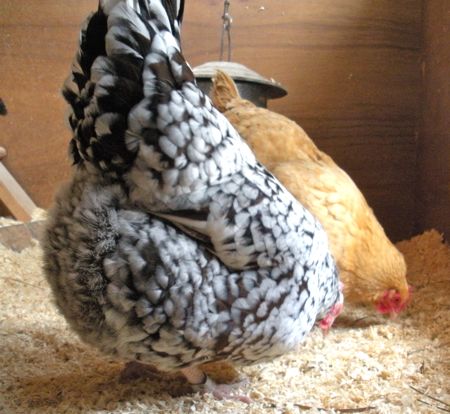Even if your chickens have lovely fluffy, feathery bottoms
and look perfectly fine, they probably harbor lice. Your hens usually keep their parasite load to a healthy minimum by taking dust baths and preening. But, in the winter, when there’s snow on the ground and no place to get good and dirty, and it’s too cold to sprawl out, anyway, lice will multiply. Pick up a chicken and take a look. You’ll need to hold her upside down and push the feathers aside to inspect the skin. I’ve got a video to show you how. Lice are almost transparent and move fast. I’ve got photos here. The first time you see them will be a “ewww” moment.
Keeping the coop clean and adding food-grade diatomaceous earth (DE) to the litter on the floor and in the nesting boxes helps. DE, which comes from microscopic lake creatures, dessicates and shreds lice bodies. (Don’t use agricultural DE, which is made from marine diatoms, and which is so sharp that it can tear internal organs!) In the summer I add DE to the dust bath wallows.
I’ve been concerned about my old hens who are stiff and lack the energy to preen. They lie in one place for hours – a perfect breeding ground for lice. I checked Eleanor, and sure enough, she was lousy, but not so severely infested that the feathers look like Q-tips from the lice detritus. (When you see that it’s really a “ewww” moment.) I checked all of the girls, and sure enough, everyone was lousy. Chicken lice don’t suck blood – they chew on feathers and skin – but they will, effectively suck suck the life out of your hens or at least make them uncomfortable and less thrifty.
I could have dusted all of the hens with DE, but I decided to pull out the chemicals. Most feed stores sell poultry lice powder in a shaker cardboard tube that looks like Ajax powder for your kitchen. It’s a chemical called permethrin- which is the synthetic form of pyrethrum, an organic insecticide derived from flowers. Poultry keepers have used pyrethrum for over a hundred years. My 1895 Biggle Poultry Book recommends it. Permethrin is more stable, with a longer shelf life and so it’s what is sold. It’s safe for poultry, but toxic to cats and fish. I only use it when I know that my hens are enclosed in their coops and not going anywhere.
So, on Wednesday I picked up each hen, turned each upside down, dusted each bottom, and set each back down. (I then put my barn coat in the wash.) Today, there’s not a louse in sight.
By the way, those of you with rescued battery hens have to be extra-vigilant about controlling external parasite because your hens can’t preen with their blunted beaks. (The factory farms dub the tips to prevent cannibalism in their crowded buildings.)


Hi Terry, I wanted to invite you to link up on my Farm Friend Friday party. I know so many of my chicken blog folks would LOVE to find your blog and this would give them a direct route. If you are interested–just go to the blog and it gives you directions. PS-I wanted to let you know my mom is getting her cochlear implant. I thought I posted that the other day but then couldn’t find it. We are so excited!
Amy :)
Hi Amy- you did post about the CI and I responded. Sometimes there’s a lag time here at HenCam central :) Very exciting about the CI!
Re the lice problem: How about Candy? Can she get them from the chickens? Or don’t lice care for rabbits?
These lice are species dependent – they don’t like people, either :)
Hello! You have spoken to my mom Elizabeth, my name is Briana! I would love it if you would follow my blog! Our chickens have been very kerfuffled about not being able to have a dust bath because of all the ice. But they have just discovered ice skating!
Briana- I just love see the word “kerfluffled” in a sentence!
I read a suggestion to use a litter pan for a dust bath for chickens. Maybe that would be useful in the hen house for the winter. They were suggesting using the diatomaceous earth in the pans. Just a thought.
We have a fantastic permethrin spray here made by Johnson’s – it’s for caged birds really, just called Lice and Mite spray. There’s a pyrethrum one too if you don’t want the persistence of the chemical. I wait until my girls are perched for the night, then give them each a spray under the arms and up the bloomers! My older big girls don’t like being handled too much these days, and as for going upside down, well, there’d be a riot, so this is the perfect solution. I then tend to quickly yank out the ‘nitty’ feathers.
A spray would be easier than dust! But, really, tucking them upside down is no problem at all – they all put up with it and don’t seem to hold any grudges towards me afterwards. You just have to be quick and hold them securely.
Wow this is some informative blog for sure, I love it, I have 4 chickens and never knew some of the things you talk about here, I live in Southern Georgia so no snow, but it does get cold, we have portable shelter my dh built, and he put the heavy bisqueen around back of it outside, where it makes it warmer for them where they roost, I just love it and going to become a follower for sure, I will add you on my favorite blogs too so I never loose track of you. Thank you for all the information I have learned here.